9mm Luger has seen a huge increase in popularity over the last decade. Justification for how a previously ‘anemic’ self-defense round is now optimum includes the following: “new bullet advancements”, “modern bullet designs”, and so on. This is said to convince the listener that 9mm Luger is no longer anemic but also equivalent to the terminal performance of never-questioned cartridges like 40 S&W and 45 Auto.
If this ‘new technology’ can be applied to 9mm, it can be applied to other bullets. The idea of a new technology having occurred in jacketed hollowpoints is often parroted but never substantiated. The lethality difference between pistol cartridges is significant enough to influence firearm selection but there is no hardware substitute for a determined and trained self-defender. A shooter is legally liable for every bullet they send downrange. Criminals are sneaky by nature and will attempt through surprise to take away your ability to react with a gun. If you could only get one mediocre shot on an attacker before they are on top of you, which cartridge would you carry?
650 jacketed hollowpoints were shot into ballistic gelatin from 9mm Luger and 45 Auto firearms for this blog post. Comparison of the two cartridges using permanent cavity diameter, kinetic energy transfer, performance against bone and FBI barrier test performance are presented below.
BARE GELATIN TERMINAL PERFORMANCE
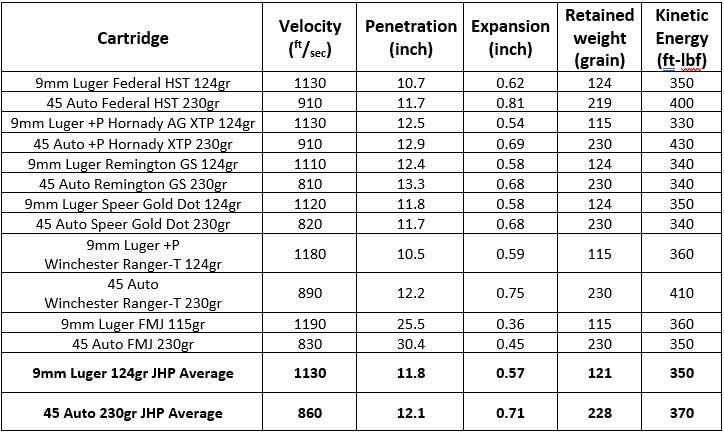
The above are 5-shot averages from a 4″ long 9mm Luger barrel and a 5″ long 45 Auto barrel. SAAMI ammunition manufacturers use these barrel lengths to control production. Bullet expansion is a key component in wounding. The 9mm Luger bullets expanded to 0.57″ and the 45 Auto bullets expanded to 0.71″ – a 25% increase in diameter. There is a correlation between bullet diameter and the diameter of the hole made by a bullet in ballistic gelatin. The larger the bullet, the larger the hole. Larger holes bleed more because there is less resistance to fluid flow through a larger ‘pipe.’ The more rapid the blood loss, the more quickly an attacker is stopped.
Much is made about bullet velocity as a wounding factor. Higher velocity does not equate to larger hole size at pistol velocity. In testing, a 9mm Luger Speer Gold Dot 124gr at 1100 ft/sec expanded to the same diameter as a 357 SIG Gold Dot 125gr at 1400 ft/sec and both made the same size hole. Permanent cavity (‘hole size’) can be compared by pulling a rod with a sphere attached at the end through a gelatin block. The force required to pull the sphere through is measured with a force gauge attached to a motorized test stand.

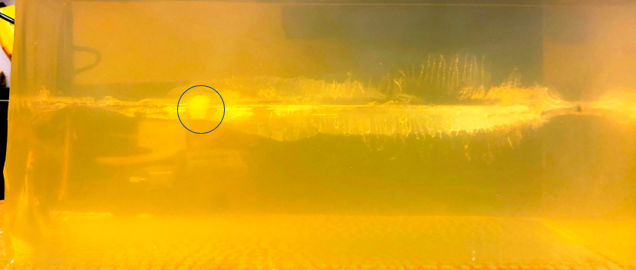
The larger the hole made by the bullet, the easier the sphere can be pulled through so the force seen by the gauge will be lower. Five Federal 9mm Luger +P HST 124gr and five Federal 45 Auto +P HST 230gr bullets were shot into bare gelatin. It took 0.30 pounds of force to pull the sphere through the 9mm track and 0.26 pounds to pull the sphere through the 45 Auto track. The 45 Auto made a bigger hole because the force required to pull the sphere through was lower.
Permanent cavity diameter is measured by casting rods of known diameter into gelatin blocks, removing the rods and pulling the sphere through the known-diameter hole. This is the correlation between force and hole diameter. In the above testing, the 9mm made a 0.090″ diameter hole and the 45 Auto made a 0.114″ diameter hole through the gelatin block. 45 Auto was a 27% increase over 9mm. The 9mm bullets expanded to 0.57″ diameter and the 45 Auto expanded to 0.72″. 45 Auto expansion is 25% greater than 9mm Luger. 27% and 25% lining up this well is not a coincidence. Permanent cavity diameter tracked well with expanded diameter despite 9mm Luger traveling 31% faster than 45 Auto.
KINETIC ENERGY TRANSFER
Since the appearance of the FBI 12″ minimum gelatin penetration depth in the mid-1980s, there has been a steady skewing and confounding of thought regarding kinetic energy transfer and its role in terminal performance. An object in motion has kinetic energy. Energy is needed to force a bullet through tissue. Kinetic energy transfer is a method of accounting for this energy input and where in the gelatin block it occurred. The more kinetic energy a bullet loses, the more damage can be done to the target. Energy is transferred pushing tissue apart, making a hole. Critics of kinetic energy transfer correctly assert that temporary cavity from a handgun is not a significant wounding factor. This is because most organs are highly elastic and will spring back minimally harmed after the passage of a bullet.

Above is the process of a hollowpoint expanding in ballistic gelatin. The Speer bullet impacted the gelatin block with 363 ft-bf kinetic energy and transferred 362 ft-lbf kinetic energy as tracked by high speed video camera. Temporary cavity is a byproduct of a bullet forcing a hole in the tissue and in comparison is not a wounding effect.

A Vision Research Phantom v711 high speed camera was used to get time and position data of the bullets moving through gelatin blocks. Each data point represents penetration depth of the bullet every 22 microseconds that the bullet was moving through gelatin. 3840 data points for bullet position versus time was obtained for the 9mm Luger JHPs tabulated above.

45 Auto is a slower moving bullet so it gives more data points. 6620 data points of position vs time were obtained for the 45 Auto bullets in the table above.

Here are two frames from the same high speed video to illustrate how kinetic energy transfer is calculated.

This is a Winchester 45 Auto Ranger-T 230gr bullet at 2.87″ into the gelatin block. It has taken 0.000289 seconds for the bullet to travel this far from the point of impact. In the interest of demonstrating this concept, the average velocity of the bullet between these two points is 2.87 inches divided by 0.000289 seconds = 9931 inch/sec = 828 ft/sec. These bullets weighed 230gr after being pulled from the gelatin block, washed and then dried. Kinetic energy can be calculated using this formula:
KE = (velocity * velocity * bullet weight) / (450240)
KE = (828 * 828 * 230) / (450240) = 350 ft-lbf

This is the same bullet at 5.16″ into the gelatin block. It has taken 0.000311 seconds to travel 2.29″ further into the gelatin block. In the interest of demonstrating this concept, the average velocity of the bullet between these two points is 2.29 inches divided by 0.000311 seconds = 7363 inch/sec = 614 ft/sec. Which corresponds to a kinetic energy of:
KE = (614 * 614 * 230) / (450240) = 193 ft-lbf
Between 2.87″ and 5.16″ penetration depth, this bullet transferred 350 – 193 = 157 ft-lbf kinetic energy to the gelatin. For reference, this is enough energy to lift a 157 pound object 1ft directly upwards.
This is the logic of calculating kinetic energy transfer of a bullet. The actual velocity of the bullet is calculated using the trendline (visible in the above two graphs) and derivative calculus. This produces much more accurate results. The derivative method is used in all calculations in this report.
The tested bullets are from the major ammunition manufacturers and are all the same weight – the 9mm Luger bullets are 124gr and 45 Auto bullets are 230gr. Weight was kept constant so that results can be combined and represented accurately as an average.
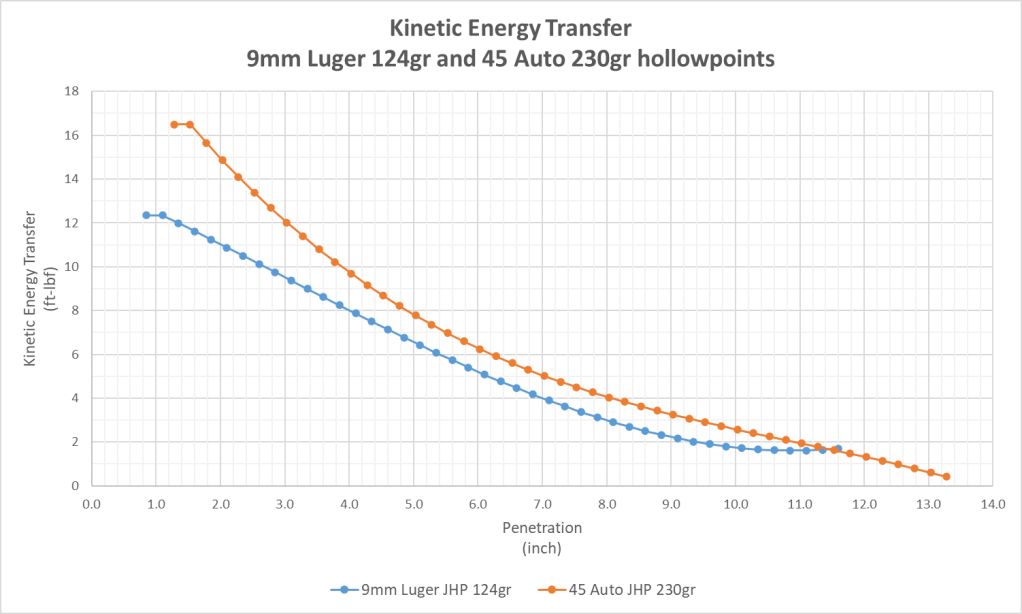
The work done by the bullet to the gelatin is equal to the work done by the gelatin to the bullet and this is what we can measure and calculate. 45 Auto kinetic energy transfer and thus terminal performance in bare gelatin is superior to 9mm Luger.
That was the average, lets look at the extremes. Below is a comparison of the 9mm Luger cartridge with the greatest kinetic energy at impact compared to the 45 Auto with the least kinetic energy at impact.
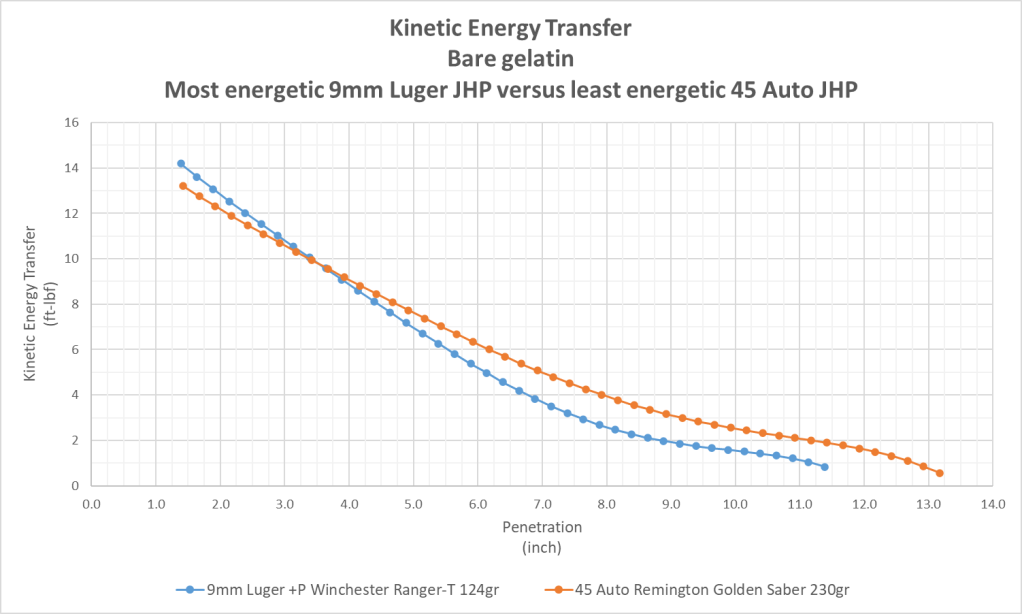
The 9mm Luger +P tested at 1180 ft/sec is slightly more effective until 3.7″ penetration depth, after which the 45 Auto is superior, even when loaded light, to 810 ft/sec as this ammunition was.
You’ve probably heard that the 9mm Luger is so much faster than 45 Auto and that velocity makes a difference. Other people argue that the 45 Auto does more damage because it is slower.


Using Speer Gold Dot as an example, a 45 Auto in the slower end of the velocity range still outperforms all weights of 9mm Luger in terms of kinetic energy transfer.

The 9mm Luger DPX 115gr bullet, traveled at 1200 ft/sec and is one of the most energetic 9mm Luger cartridges available. 45 Auto +P DPX 160gr bullet also traveled at 1200 ft/sec and is a 160gr bullet versus the 115gr bullet of the 9mm Luger. 45 Auto dominates here as well.
PERFORMANCE AGAINST BONE
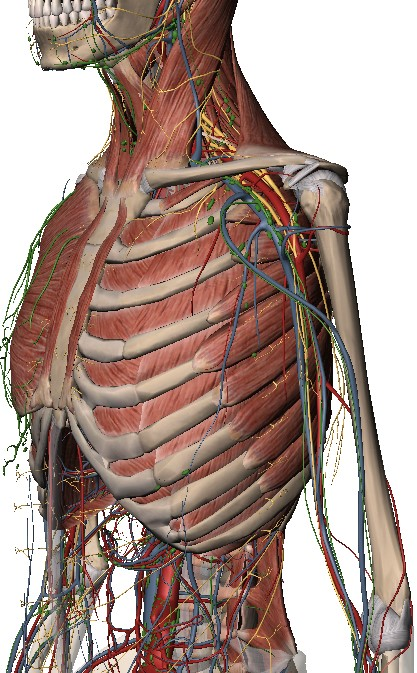
Bullets hit bone frequently during gunfights. The vast majority of JHP bullets must hit soft tissue prior to bone or they will not expand. Quoting the FBI’s Handgun Wounding Factors and Effectiveness:
“Handgun bullets expand in the human target only 60-70% of the time at best. Damage to the hollow point by hitting bone, glass, or other intervening obstacles can prevent expansion.”
It is reasonable to expect conventional pistol JHPs to fail to expand most of the time. What matters is how to make this situation less worse in the likely event it occurs. 70 rounds of premium 9mm Luger expanding ammunition and 60 rounds of premium 45 Auto expanding ammunition were shot through bare gelatin blocks and through Synbone 6mm thick bone simulant plate placed in front of bare gelatin blocks.



























The table below shows the performance of these bullets in bare gelatin and bone simulant plus gelatin in {brackets} immediately to the right. For example, a 9mm Luger +P Cor-Bon DPX 115gr bullet penetrates 13.5″ in bare gelatin and 12.0″ in bare gelatin placed behind the bone plate. The metric of Average Kinetic Energy Transfer is the bullets kinetic energy at impact with the gelatin, divided by the penetration depth. The table below shows the average of five shots per cartridge.

The Barnes copper bullets and Federal EFMJ bullets expanded after hitting bone. No jacketed lead core bullets expanded. Below is what to expect in terms of kinetic energy transfer from bullets which do not expand.

9mm Luger and 45 Auto Remington Golden Saber, performed equally as bad after failing to expand after bone. There is a saying that goes: “they all fall to hardball.” Hardball being slang for a 45 Auto FMJ 230gr bullet.

Whoever said that about 45 Auto FMJ 230gr must not have been aware that the 9mm Luger FMJ, which has significantly better terminal performance in bare gelatin than 45 Auto, is also a huge underperformer in real life. An example of this is the Amadou Diallo shooting in 1999. He was shot at 41 times by the NYPD and hit 19 times (accounts vary) with 9mm FMJ before he collapsed. For those keeping track, that is a hit probability of 46% against a subject who was not returning fire. Nervousness increases greatly with the appearance of muzzle flashes so expect to get even worse than 46% hits in a gunfight.
9mm Luger FMJ is more effective in soft tissue than 45 Auto FMJ because the ratio of length to diameter is greater with the 9mm FMJ – it is more like a rifle bullet shape than 45 Auto FMJ 230gr. If you live in a political jurisdiction that doesn’t respect your right to self-defense and restricts gun owners to FMJ only, you should move for this and many other reasons. If that is not possible then carry 9mm FMJ 147gr to maximize the length-to-diameter ratio which leads to bullet instability and earlier tumbling in soft tissue. This is how a JHP that fails to expand after bone compares to both 9mm FMJ 115gr and 45 Auto FMJ 230gr:

We are not recommending 9mm FMJ over JHPs in either caliber for any reason. There are still many shotlines through vital areas that hit soft tissue first, so expanding bullets are still mandatory. This graph provides a reference to understand how poorly both pistol FMJs and JHPs that fail to expand in soft tissue perform. Below are still images taken from high speed video of this testing.





JHPs that fail to expand are more effective after 7 inches of soft tissue. The vital organs are located well within 7 inches of the skin on the vast majority of shotlines so it goes without saying how important JHP expansion is to wounding efficiency.
The only bullets that performed well against bone was the Cor-Bon DPX (Barnes TAC-XP) and Federal Expanding Full Metal Jacket. Cor-Bon doesn’t currently load the DPX 160gr to +P pressure and Federal currently doesn’t catalog Expanding Full Metal Jacket. These bullets function when conventional jacketed lead hollowpoints don’t because they do not plug with bone as easily or at all in the case of the EFMJ.
Federal EFMJ (Guard Dog) is a jacketed lead core bullet with polymer ball in the ogive/meplat area.

Image from https://www.firearmsid.com/bullets/bullet1.htm
The EFMJ cannot plug and fail to expand because it doesn’t have a cavity to plug. Barnes copper pistol bullet cavities can accommodate foreign material such as bone while still allowing fluid around the plug to fill the cavity and cause expansion.
9mm Luger +P Cor-Bon DPX 115gr impacted the bone at the same velocity as 45 Auto. The expansion of both wasn’t effected by bone. 45 Auto DPX averaged 43 ft-lbf kinetic energy transfer per inch of penetration and 9mm Luger DPX averaged 30 ft-lbf kinetic energy transfer per inch of penetration. 45 Auto EFMJ also performed comparatively better than the 9mm Luger EFMJ. All JHPs tested failed to expand after impact with bone.
Once someone feels like a deeply held opinion is challenged by laboratory data, they will quickly denounce the testing as not being representative of the ‘real world’. The following tests use simulant materials (pig skin, bone plate, gelatin) with the same density and arrangement as real world targets (shots to rib cage, femur and pelvis.)

Three shots of Speer 9mm Luger +P Gold Dot 124gr were shot into this target and lost 357 ft-lbf kinetic energy. Three shots of Hornady 45 Auto +P XTP 230gr were shot into this target and lost 367 ft-lbf kinetic energy.

The 9mm Gold Dot lost 158 ft-lbf in this target while the 45 Auto XTP lost 205 ft-lbf in this target simulating the thigh.

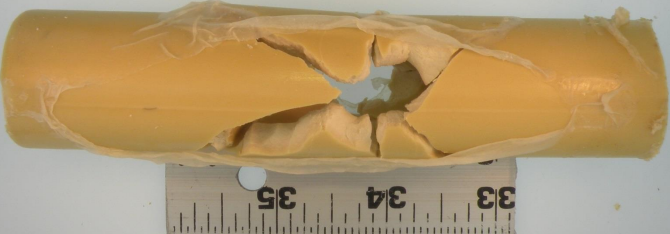


Both bullets damaged the bone tubes enough that they could not bear any weight. For a femur, that would have been a disabling hit in both cases.

In the pelvis target, 45 Auto transferred 201 ft-lbf and 9mm Luger transferred 191 ft-lbf.
FBI BARRIER TEST PERFORMANCE
When the FBI buys ammo it publishes a list of performance criteria that ammo must meet. These criteria are commonly referred to as the FBI Barrier Test Protocol. This test protocol consists of shooting bullets through bare gelatin, bare gelatin covered in heavy clothing and through barriers including drywall, plywood, sheet metal and automobile glass. Full details about the FBI protocol here. Unless your actions are covered by qualified immunity, you should think deeply about the rationale of making ammunition selections based on what a bullet will do on a blind shot through these barrier materials. Regardless of the circumstances that preceded the shot (example: adversary using a door frame for cover), pulling the trigger still violates the safety rule of knowing your target and what is beyond. A bullet must penetrate 12.0″ or deeper in ballistic gelatin to do well in the FBI Barrier Test Protocol. Any bullet that does not meet this minimum depth will score poorly/not sell to many law enforcement agencies. As such, almost all jacketed hollowpoints today will give up some expansion in favor of deeper penetration. Many law enforcement agencies will base their ammunition procurements on what the FBI finds did the best in their testing. An FBI ammunition contract is lucrative and this greatly influences the terminal performance of JHPs on the market.
The ‘FBI Score’ of a bullet is a number of points out of 500. Every solicitation from the FBI seems to have slightly different scoring criteria in the same cartridge and there are significant differences in criteria between two different cartridges. Here are some scores for both 9mm Luger and 45 Auto products:

The cartridges above were not specifically marketed as being made for the law enforcement market so it is reasonable to expect mixed performance when shooting these through the FBI Barrier Tests. Speer makes the Gold Dot 2 specifically to do well in the FBI Barrier Tests.

As mentioned earlier, the scoring criteria is a caliber-specific score out of 500 points possible. Note that an assailant doesn’t care what caliber you are using. They only care if you have a gun or not and are willing to fight. Assuming a future justified use of force – the target will be the same, and you have the choice to decide now what ammo you will be carrying. Since we want to find out which cartridge is better for shooting through barriers, the 9mm Gold Dot G2 was scored using the 45 Auto criteria.

Using FBI scoring criteria and two bullets designed to perform as well as possible on the FBI Protocol, 45 Auto scored higher than 9mm Luger.
Shooting blindly through barriers is already legally and tactically questionable. But let’s go on and look at how much energy each bullet has to work with after passing through the opposite side of the FBI barrier materials.

The biggest takeaway in the above table is the large amount of kinetic energy lost when a pistol bullet encounters a barrier and the similar performance in terms of barrier penetration ‘efficiency’ between 9mm and 45 Auto. In both cases you are starting off with not much gun (a handgun) and end up with much less once you start shooting through barriers.
Below is how many common 9mm Luger and 45 Auto bullets from full-size handgun length barrels function in the FBI Barrier Test Protocol.

Here is what bullets recovered from Bare gelatin look like:

Kinetic energy transfer of the Hornady 9mm Luger +P American Gunner XTP 124gr and Hornady 45 Auto +P XTP 230gr in bare gelatin:
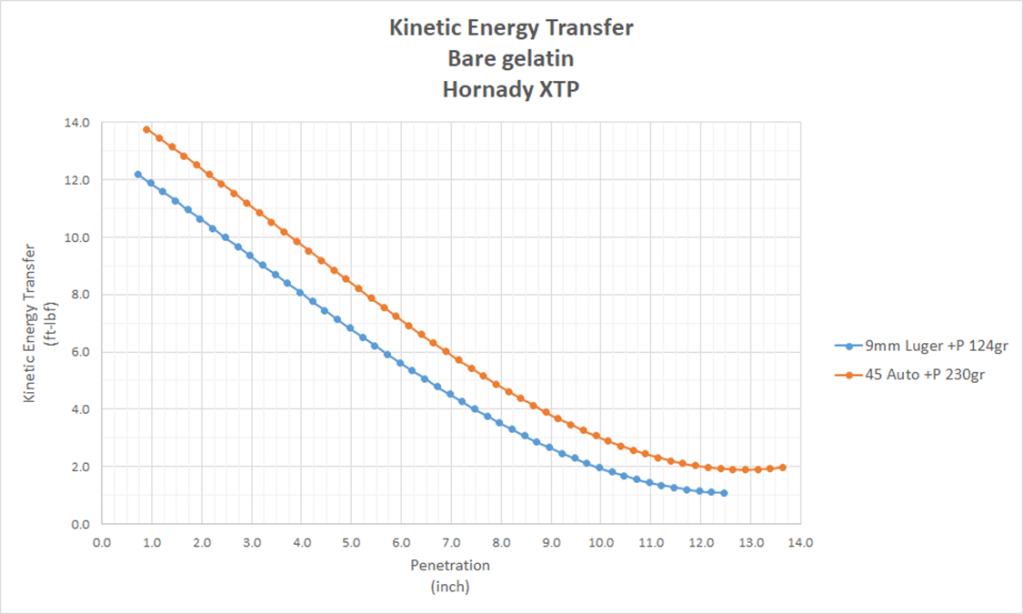
Advantage 45 Auto.
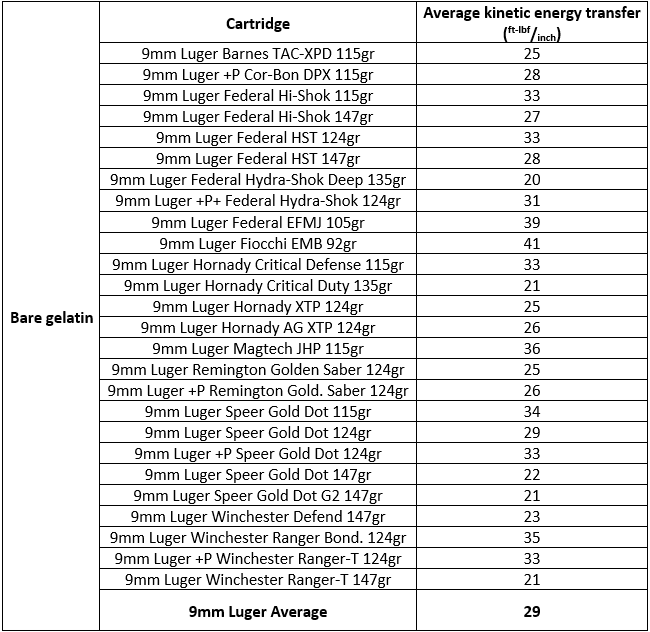

The greater the kinetic energy transfer, the more damage the bullet did to the target. 45 Auto (35 ft-lbf/inch) is superior to 9mm Luger (29 ft-lbf/inch) here as well.





It’s a tie between 9mm Luger and 45 Auto here. Because the vast majority of law enforcement ammunition purchases over the last 30 years have been for 40 S&W and 9mm Luger, it is no surprise that 45 Auto bullets have not gotten as much R&D money as these other two. It takes lots of R&D work to get a bullet to expand as reliably in heavy clothing as it does in bare gelatin. Hollowpoints that clog with skin (all of them) closely resemble bullets shot through heavy clothing and recovered from gelatin. Heavy clothing performance is important for this reason.



Bullets do unpredictable things when they are shot through solid objects. Pistol bullets can lose up to 33% weight and 66% kinetic energy going through auto glass. Bullets change path behind the glass randomly. Shooting through auto glass is a solution of last resort.
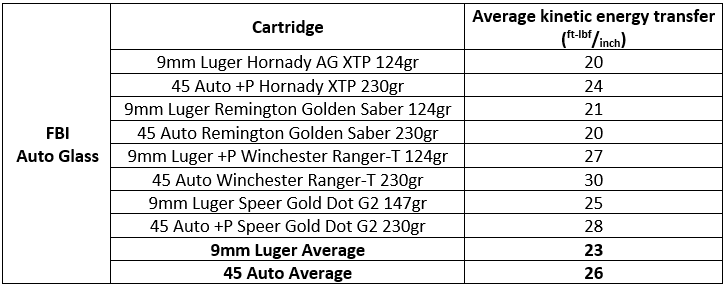



Bullets striking sheet metal will ‘nailhead’ instead of expand as the ogive is smashed into the shank. In the instance above the 9mm XTP nailheaded more than 45 Auto XTP which also lost 18% weight, which is unusual in this barrier. Generally though, 45 Auto is superior to 9mm Luger in sheet metal as well.

At some point, a need apparently arose to shoot pistol bullets blindly through the interior walls of houses. This test is not to assess safety to bystanders in case of a miss – hollowpoints do not expand in interior walls, they expand in the gelatin block.




Advantage 45 Auto.
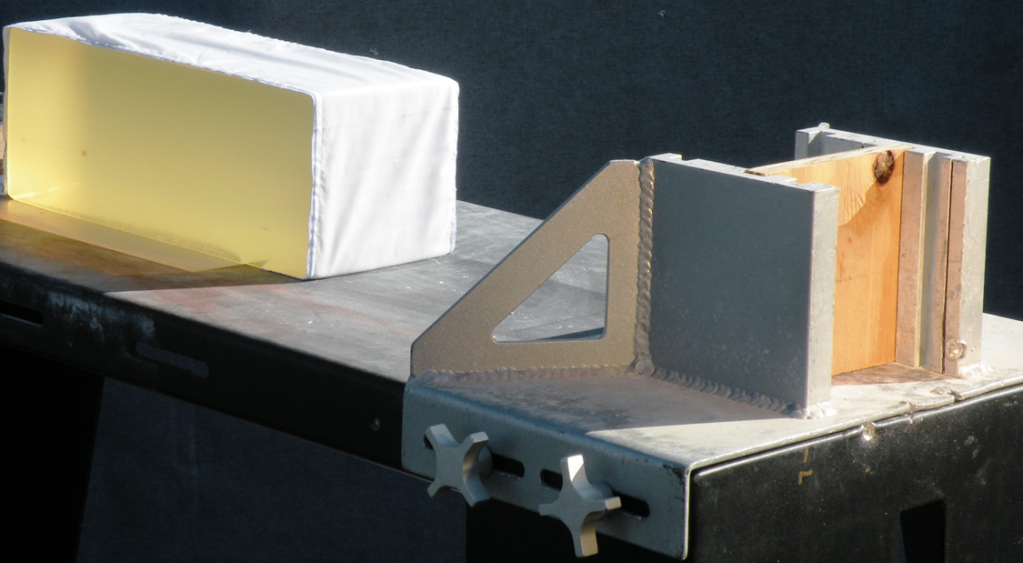

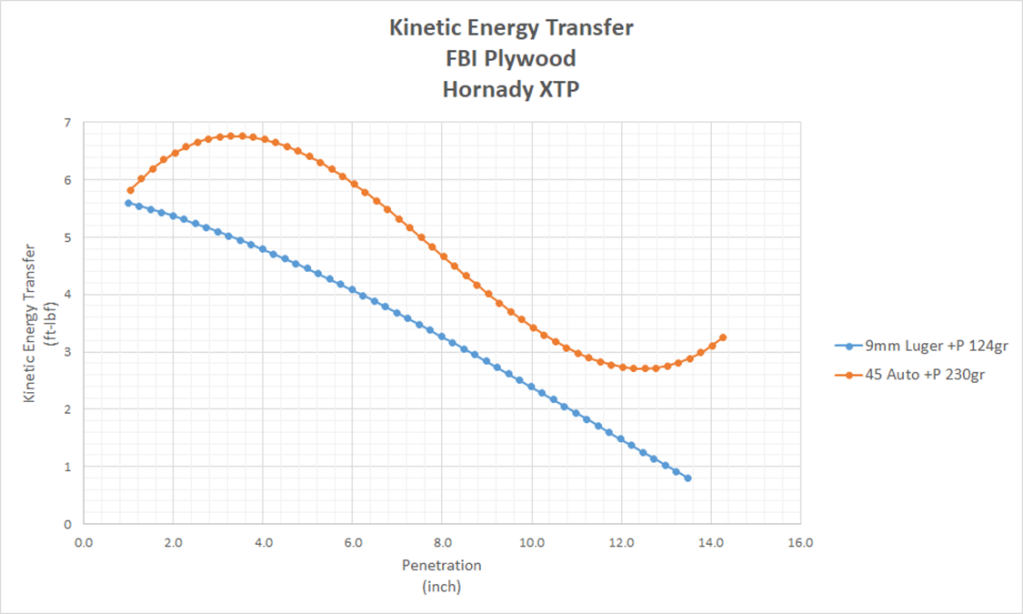
The 45 Auto XTP failed to expand and immediately destabilized. This is not typical JHP performance in the plywood as the majority will expand at least partially in gelatin.

As a hollowpoint bullet needs to be designed to spit the plug of plywood out by the time it has traveled the 18 inches between the plywood and the gelatin block, the effect of increased R&D spending on 9mm Luger bullets becomes obvious with this barrier test.

Advantage 9mm Luger.
45 Auto cartridges offer superior terminal performance to 9mm Luger cartridges shooting expanding bullets. This is applicable to a full-size 45 Auto with a 5″ barrel and a 9mm Luger with 4″ barrel as is popular today. These are the barrel lengths that SAAMI members use for their ammunition development and production control. We gave the bullets the best chance to work well by using the barrel lengths they were designed in. Larger diameter pistol bullets will cause more effective wounds.
Consider going back to 40 S&W in favor of 9mm Luger and going with 45 Auto if you are willing to carry a larger firearm that holds less ammunition. Unless you are covered by qualified immunity, you should not be considering a handgun bullet for its barrier performance (bare gelatin and heavy clothing are what matters most, everything else is a fringe benefit) nor considering a gun for its magazine capacity (with the unspoken tendency towards ‘spraying-and-praying’ a higher capacity tends to cause.)
Go with the largest diameter and most energetic cartridge that you can shoot well. There are no points awarded in a fight for ineffective shots. Weigh the time and effort you can spend practicing against the controllability of the biggest gun that you can carry. Shoot a police qualification with a full-size 45 Auto. If you can pass the qualification, the next logical step upward is 45 Super. Unfortunately, 45 Super is not a SAAMI cartridge and is currently only loaded by two manufacturers using bullets with sub-optimal terminal performance for that platform. It would be the best choice for self-defense if loaded with the Barnes TAC-XPD 185gr bullet. What should happen once you qualify with the full-size 45 Auto is to decide to stay with that setup or keep the cartridge and move down in gun size to increase comfort carrying concealed. Remember that you pay for what you get. Barrels get shorter as guns get smaller. Shorter barrels lead to less velocity and less velocity means less bullet expansion so lower terminal performance.
Shoot the qual again with a compact 45 Auto, then a subcompact. If you can pass qualification with all of these, then the world is your oyster, so to speak. Try to step up to 45 Super in any of these platforms. If you cannot qualify with a full size 45 Auto pistol, you should seek additional firearms training. A logical starting point if 45 Auto is not an option is a 40 S&W full size handgun and then repeat the qualifications with guns of decreasing size. 9mm Luger is most advantageous when up-gunning the smallest of concealed handguns from 380 Auto. Both use the same diameter bullets but the two cartridges are in a different category from each other in terms of terminal performance. Be aware that a sub-compact 9mm Luger handgun is an expert’s gun – the discomfort of shooting such guns discourages training, which is most needed with these given the diminutive cartridge and small control surfaces.
In the words of my Uncle Mike – stay alert, stay alive.
Leave a comment